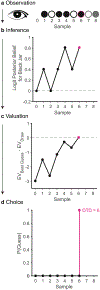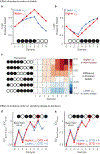Rethinking delusions: A selective review of delusion research through a computational lens
- PMID: 33676820
- PMCID: PMC8413395
- DOI: 10.1016/j.schres.2021.01.023
Rethinking delusions: A selective review of delusion research through a computational lens
Abstract
Delusions are rigid beliefs held with high certainty despite contradictory evidence. Notwithstanding decades of research, we still have a limited understanding of the computational and neurobiological alterations giving rise to delusions. In this review, we highlight a selection of recent work in computational psychiatry aimed at developing quantitative models of inference and its alterations, with the goal of providing an explanatory account for the form of delusional beliefs in psychosis. First, we assess and evaluate the experimental paradigms most often used to study inferential alterations in delusions. Based on our review of the literature and theoretical considerations, we contend that classic draws-to-decision paradigms are not well-suited to isolate inferential processes, further arguing that the commonly cited 'jumping-to-conclusion' bias may reflect neither delusion-specific nor inferential alterations. Second, we discuss several enhancements to standard paradigms that show promise in more effectively isolating inferential processes and delusion-related alterations therein. We further draw on our recent work to build an argument for a specific failure mode for delusions consisting of prior overweighting in high-level causal inferences about partially observable hidden states. Finally, we assess plausible neurobiological implementations for this candidate failure mode of delusional beliefs and outline promising future directions in this area.
Keywords: Beads task; Computational psychiatry; Delusions; Inference; Psychosis; Schizophrenia.
Copyright © 2021. Published by Elsevier B.V.
Conflict of interest statement
Declaration of competing interest
The authors declare no conflicts of interest.
Figures



Similar articles
-
A distinct inferential mechanism for delusions in schizophrenia.Brain. 2019 Jun 1;142(6):1797-1812. doi: 10.1093/brain/awz051. Brain. 2019. PMID: 30895299 Free PMC article.
-
[Etiopathogeny of the delusion of pregnancy using a literature review: Role of hyperprolactinemia and application of the theory of abductive inference].Encephale. 2014 Apr;40(2):154-9. doi: 10.1016/j.encep.2013.04.008. Epub 2013 Jul 4. Encephale. 2014. PMID: 23830681 Review. French.
-
Subjective experience and meaning of delusions in psychosis: a systematic review and qualitative evidence synthesis.Lancet Psychiatry. 2022 Jun;9(6):458-476. doi: 10.1016/S2215-0366(22)00104-3. Epub 2022 May 4. Lancet Psychiatry. 2022. PMID: 35523211
-
Delusions beyond beliefs: a critical overview of diagnostic, aetiological, and therapeutic schizophrenia research from a clinical-phenomenological perspective.Lancet Psychiatry. 2021 Mar;8(3):237-249. doi: 10.1016/S2215-0366(20)30460-0. Epub 2021 Jan 21. Lancet Psychiatry. 2021. PMID: 33485408 Review.
-
Resolving the Delusion Paradox.Schizophr Bull. 2023 Nov 29;49(6):1425-1436. doi: 10.1093/schbul/sbad084. Schizophr Bull. 2023. PMID: 37478890 Free PMC article. Review.
Cited by
-
Bayesian accounts of perceptual decisions in the nonclinical continuum of psychosis: Greater imprecision in both top-down and bottom-up processes.PLoS Comput Biol. 2023 Nov 21;19(11):e1011670. doi: 10.1371/journal.pcbi.1011670. eCollection 2023 Nov. PLoS Comput Biol. 2023. PMID: 37988398 Free PMC article.
-
Transdiagnostic Anxiety-Related Increases in Information Sampling are Associated With Altered Valuation.Comput Psychiatr. 2024 Nov 6;8(1):202-216. doi: 10.5334/cpsy.100. eCollection 2024. Comput Psychiatr. 2024. PMID: 39524300 Free PMC article.
-
Everything is connected: Inference and attractors in delusions.Schizophr Res. 2022 Jul;245:5-22. doi: 10.1016/j.schres.2021.07.032. Epub 2021 Aug 9. Schizophr Res. 2022. PMID: 34384664 Free PMC article.
-
Sweet spot in music-Is predictability preferred among persons with psychotic-like experiences or autistic traits?PLoS One. 2022 Sep 29;17(9):e0275308. doi: 10.1371/journal.pone.0275308. eCollection 2022. PLoS One. 2022. PMID: 36174035 Free PMC article.
-
Loneliness and delusion-like experiences among women: Mediating role of procrastination and boredom proneness.PLoS One. 2025 Aug 4;20(8):e0329607. doi: 10.1371/journal.pone.0329607. eCollection 2025. PLoS One. 2025. PMID: 40758716 Free PMC article.
References
-
- Adams RA, 2018. Chapter 7 — Bayesian inference, predictive coding, and computational models of psychosis. In: Anticevic A, Murray JD (Eds.), Computational Psychiatry. Academic Press, pp. 175–195.
-
- Adams RA, Brown HR, Friston KJ, 2014. Bayesian inference, predictive coding and delusions. AVANT V (3), 51–88.
-
- Ambuehl S, Li S, 2018. Belief updating and the demand for information. Games Econom. Behav 109, 21–39.
Publication types
MeSH terms
Grants and funding
LinkOut - more resources
Full Text Sources
Other Literature Sources
Medical

